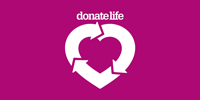Monty Klieman
(Heart Transplant 1993)
I had been an 'in and out' coronary care patient since 1976, at the Moorabbin Hospital. In 1991 the cardiologist diagnosed me as terminally ill. He said that he had exhausted his knowledge, and resources, and could do no more for me.
We decided to get a second opinion. An appointment was made with another cardiologist, He gave me a thorough examnation, studied my medical history. As a result he made an appointment for me with the director of the Transplant Unit at the Alfred Hospital.
At the consultation with Prof. Don Esmore, the director of the Transplant Unit, reviewed my case and gave me a thorough examination. As a result he informed me that I was sufficiently incapacitated to go through the assessment program to establish my overall suitability, but to secure placement on the waiting list, I would have to have one hundred per cent consensus of the transplant team.
I underwent many intensive tests, medical procedures, physical examinations, and psychological tests, plus various interviews, some involving all my family.
The results and consequence being that I was placed on the heart transplant waiting list and given a pager so that they could contact me at any time of the day or night. We were overjoyed. We could now hope for an answer to our prayers.
Being placed on the waiting list is no guarantee that one will survive the wait. The object now was to keep as fit as possible and to outlive the waiting list.
Every thing possible was done to support me at home. Special handrails and a portable ramp were fitted to the house. Moorabbin Hospital provided special aids to help me to be partially self-reliant. During my wait for a donor heart the Moorabbin Hospital was merged with the Monash Medical Centre, resulting in the closure of the Emergency Department and the Coronary Care ward. I was the last patient to be moved out of the Coronary Care Unit on the day of closure. I also had the undesirable record of having the most admissions! I was then transferred to the Alfred Hospital.
The pager went with me everywhere and the alarm went off a number of times, the initial excitement followed by despondency when the calls turned out to be false alarms. It was very stressful and detrimental to my disposition, temporary affecting my self-esteem and morale. I became so weak I could no longer stand and had graduated to a wheelchair.
I recall vividly one incident when I was at home, I was in the bathroom alone trying to clean my teeth. I started slipping to the floor but some how managed to sit partially on the side of the bath, I was unable to control myself and slipped further, bottom first down into the bath. Try to imagine me doubled up with my feet splayed pointing at the ceiling. I was completely helpless. I yelled for Leila my wife. You should have seen her face, the horror, and disbelief that simultaneously projected her anxiety and concern. I thought it was impossible for her to pull me out, but she tried very hard.
Leila assessed the situation and with her ingenuity and rational, tied two dressing gown cords round my waist with the other end tied to the wheel chair and, slowly inched me up and out. It was a tremendous feat and a great relief to us both.
I developed a most bizarre habit: I perused the papers and watched the TV looking for reports of any fatal accidents. Speculating as to the outcome, thinking, is that a potential donor and how was the bereaved coping with the tragic trauma of losing a loved one and making the decision to donate the organs?
I was unable to sleep at night and listened regularly to radio 3AW and the program the 'Overnighters', a nighttime talk back show. I called the station most nights, whether at home, or in hospital, and related on air various stories about my life. I even received some fan mail from the listeners! Many listeners called the station offering me hope and support during my long wait for the 'CALL'. Station 3AW sent me a pile of easy reading books.
On one occasion during the night in the Coronary Care ward, the nursing staff joined me on the talk back session, and it was suggested in fun that the radio station should send Pizza's for the night staff. It was 4 am. We did not anticipate any consequences. Surprise!!! The pizzas did come, and were enjoyed by all!!
I had been nineteen months on the waiting list and my health was deteriorating rapidly. I was still in the coronary ward. I needed to get away from this environment and to be with my family and friends
Most Saturday nights our friends dine out. This particular night the heavens opened up. I asked Leila if she would like to take me in the wheelchair to the restaurant. I think Leila realised that I wanted one last fling. Hiding behind her brave face she got me into wheelchair then into the car. Stacked the wheelchair in the boot, getting drenched at the same time. We then joined then our friends in the restaurant.
I cannot remember what meal I ordered but I know I drank a lot of wine. Without taste buds I did not appreciate the meal, even though it was in lieu of 'Sustagen' which was my staple diet. Nor did the wine have any effect on me!! Leila then drove me home on flooded roads. The rain did not ease up all evening. At least I'd had my fling.
The following Sunday the twelfth of September 1993 the phone rang at 5.45 p.m. We had finished our evening meal some thirty minutes earlier. Leila answered the call. It was the transplant Coordinator, and Leila assumed that she was just checking up on me.
The Coordinator wanted to know how I was, and how long it was since I had eaten. Leila told her about half an hour ago. The reply was "can you bring Monty to the Emergency Department by 7 p.m., we think we may have a heart for him?"
For the first time in all the time since I have known her Leila was lost for words, and just a mite hysterical; also very jubilant! We had been waiting nineteen months for this moment, and yet it was a total surprise.
My adrenalin raced to fever pitch, and my heart was beating so fast, I thought I would have a heart attack, or that I would be too ill to have the transplant operation. I was thrilled, yet very worried.
The normal procedure to select a recipient, is to bring two waiting patients to the hospital, and into the preparation ward. The final choice is then dependent on the best match, degree of the severity of the illness, and the length of waiting time, and this was all subject to the heart being vetted. There was only a 50/50 chance that I would be selected.
Leila phoned our two daughters. They raced to our home, and we all went to the Alfred Hospital The coordinator met us at Emergency, and conducted us to the preparation room, but until the heart was approved we would be on standby.
Luckily, I was the only candidate this time, and was prepared irrespective of whether the operation went ahead or not, and I was taken to the operating theatre.
At 11 pm. the go ahead was given. The three girls were offered blankets, etc, to stay in the waiting room, but Prof. Esmore advised them to go home, and that he would phone them as soon as the operation was over. This they did, and sat and talked all night in front of the TV. It was on, but they neither saw nor heard it.
Being understandably anxious and impatient they phoned Prof. Esmore at 6 am. He had just finished, and was about to phone them to say that I was in the recovery ward, and that they could visit me right away.
The most amazing experience was when I left the intensive care ward, and the machinery etc was disconnected, I was breathing normally and unassisted. Moreover I had no pain from the chest wall incision. It was unbelievably fantastic.
To combat any early rejection, the first large dose of the immuno-suppressants is administered with your pre-med. Post operation, a period of trial and error is the norm in ascertaining the strength of the anti rejection medication, which is relative to your body weight. Regular biopsies to check for rejection are made by taking snippets from the heart (or lung!) and analysing them. A not too uncomfortable procedure.
I had to learn to walk again, with the support of a walking frame and with aid of the physiotherapist. I commenced an exercise program almost immediately, as I was determined to walk out of the hospital unaided, which I did six weeks later. The euphoria I experienced walking out of the hospital and being in the land of the living with my family was ecstatic beyond words. The hand of man had resurrected me, all be it at the traumatic demise of my donor's bereaved family. Did I have the right to rejoice?
I wrote a letter to the donor's family expressing my condolences and my gratitude (a weird contradiction) and letting them know of my near one hundred per cent return to the way of life I had prior to my prolonged illness. With the hope that it gave the donor-family some consolation. The letter was anonymously written and was forwarded per the transplant coordinator as per the organ donor/transplant protocol.
My welcome home was straight into the bosom of all my family and friends. Without the support of my wife, children, and grandchildren throughout the many years of my illness, I would not be who and what I am today.
Also the fantastic support and care of all the staff of The Alfred Hospital Transplant Clinic, then and ongoing, is phenomenal. I now live a "normal" life. Life is for the living, and living my life now is one massive bonus!!!
Going Under in the Year 2001
Prior to my heart transplant my wife Leila had a history of gynaecological disorders and partially corrective surgical procedures and operations. Post my transplant Leila has and still is battling Chronic Fatigue Syndrome. Currently she is waiting to have two more gynaecological operations.
I have a steel plate in my neck, and in arteries of each leg are two stents. Also I am waiting to have another operation on my neck. In spite of these medical irritations, life has to be lived and for today.
We are still in control of our lives, and are not yet ready to take a back seat in the direction of our lives.
My children and especially grandchildren consider I am old. I mean old. I am sixty-seven years young and being a heart transplantee, their concern for me is wonderful and cherished, also understandable. However my brain does not accept and react to getting older as my body does.
Old age, and or infirmity might mean taking a back seat and letting the younger ones live their own lives and fulfilling their aspirations which is their right, but it also can condemn the retirees to silence with unspoken thoughts whether valid or not. It can be a bitter and frustrating pill to swallow. But growing older has imbued me with a sense of mature diplomacy and when that fails me I resort to diplomatic immunity.
I know the children worry about us as we do them. I can assure you that Leila and I have all our faculties contrary to public opinion, they may be not one hundred per cent, but who has?
We do it because we can.
We towed an 18 ft. caravan from Melbourne destination Karumba, on the Arafura Sea in far north Queensland. A minor detour to Mt Isa was made as we had pre-booked a guided tour deep inside the mine.
Mt Isa with a population of 23,400 is a large country city with wide divided roads and every modern amenity. In fact it claims to be the largest city in the world in an area measuring forty one thousand two hundred and fifty five square kilometres.
Living expenses and the amenities all comes at a much higher cost than we pay in the capital cities. It is due to the enormous transport costs to bring every commodity to the city. Nevertheless the Commonwealth Government has withdrawn the outback income tax concessions for their own incomprehensible reasons. The local residents are not impressed.
We did an average weekly shop in Woolworths and spent a fifth more than in Melbourne.
Mount Isa was the site, where in 1923 John Campbell Miles discovered ore deposits. The deposits proved to be rich in copper, silver, and lead.
The mine provides two separate tours for the public, i.e. a surface tour and an underground tour. The latter is limited to eight. We had booked the underground tour four months in advance.
We presented ourselves at seven thirty that morning at the tourist office to join the tour of the mine. After a short explanatory talk we signed an indemnity form. We were then taken to a shed and handed a white boiler suit, a miner's helmet with the torch attached, mining boots with steel toecaps, a heavy waist belt, safety glasses, and gloves. Naturally a photographer was present.
We were then transferred per minibus to the mine site. Entering the site the road crossed enormous tracts of land that had been virtually scraped bare, and further open cast (surface) mining was currently in progress, with massive bulldozers and gigantic mechanised mobile equipment. The landscape had the appearance of a vast lunar like complex. It was awesome.
The mine's total surface area including all the many workshops, offices, staff amenities, services, the copper and lead smelters etc is five kilometres long and one point two kilometres wide
The guide assured us that when each tract of mineral is fully mined the landscape would eventually be restored. The mine and its chemical processing plants more than conform to the highest ecological standards and regulations.
The pithead was a large conglomerate of industrial buildings. Passing through a security check, we were escorted into a small lecture room that was adjacent to the miners' lockers and where the safety equipment was kept.
A retired miner introduced himself as our guide and spoke about the safety requirements followed by a video film. We were then allocated heavy square oxygen cylinders. It was then apparent why we were given the heavy strong belts to wear. We attached the cylinders to the belts.
We are all familiar with the site of a mine's wheelhouse. It is the control tower for the cages that are suspended on cables from the large wheel at the top of the tower. It controls the descent and ascent to and from the bowels of the earth. It is the main entrance for the work force and equipment of every description, and is the means of bringing the ore bodies to the surface.
We descended one thousand meters in the cage attached to the wheelhouse in seconds. Any apprehensions we had about the descent were superfluous. There was no sensation. I was pleasantly surprised.
We boarded a four-wheel drive; open troop carrier for the tour. Riding in the back, we were shown some of the workings with explanations etc of a few of the kilometres of the nine hundred and seventy five kilometres of roads and tunnels.
Very large caves built into the solid rock off the side of the tunnels housed modern industrial workshops and are located throughout the mine to service the 'hi-tech' plant and machinery.
My preconceived impressions based on my experiences of working amongst a Yorkshire mining community forty years ago were completely and pleasantly shattered.
The ten to twenty metre high tunnels (necessary to transport the machinery and mechanised/computerised plant) were clinically air-conditioned and practically dust free. We did
walk through small pools of water on rough ground when we stopped to inspect different parts of the mine.
After blasting at the ore face dump trucks are sent in with buckets capable of lifting forty tonnes of ore and rubble at a time and depositing it into a shaft some distance away. The truck is operated by remote control. The truck had video cameras back and front. The controller sat in his air-conditioned office for twelve hours at a time with two joysticks in front of two monitors, some distance away.
The remote controlled truck tipped its load into a shaft falling eighteen hundred meters below the surface. It is the deepest part of the mine that is worked, and the temperature there is sixty degrees Celsius. We would not be going there.
The blasted ore bodies were then loaded onto the cages and brought to the top for processing in the copper or the lead smelter.
Stopping the four-wheel drive in a cavity to allow heavy machinery to pass, the headlights were the only source of light. The tour guide warned us that without the headlights on, we would be in total darkness, and will prove his point for just a few seconds. It was impossible to see ones own self. It was the longest fifteen seconds that I had experienced.
We then drove to the surface via a long winding sloping road into bright sunlight
(Written by Monty Klieman, with just a few 'edits' by yours truly!!)





